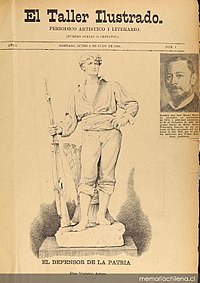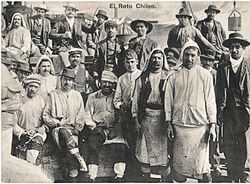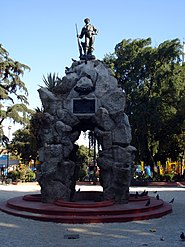Chilean broken
The substantive adjective broken was originally used in Chile to refer, in general, to a human type: the person of urban and poor origin.
The term has been used with different connotations: classist in the 19th century, as opposed to aristocrat, it was defined as peasant, uneducated and with bad habits; affective, especially in its diminutive form, and epic. In Chile since the beginning of the 20th century, the roto has been considered a figure of national identity and an archetype of Chileanness, coming to define a "brave, proud and joyful" person.
Origins
During the Spanish colonization of the Americas, the conquistador Diego de Almagro returned from Chile to the Governorate of Nueva Toledo through the Atacama desert in 1537. The journey was disastrous; Such was the state in which Almagro and his followers arrived that from then on those who came from those lands were called "broken", that is to say "ragged, scruffy".
[...] those of Chile were in such poor condition, for no one gave them work or possibilities of unfolding in some activity, that by their happies they called them the broken Chileans.
[...] on Sunday June 26, 1541, [...] broken As they called the soldiers of Almagro for their extreme poverty, Pizarro was killed in a depressive "state coup".
A well-known popular song from Chile demonstrates the link between ragged appearance and social contempt with the word "roto".
- Women don't want me.
- 'Cause I got the poncho. broken
- easy fixing girls
- I take this one off and put on another.
Isabel and Angel Parra, "Cuartetas por Fun", fourth estrofa, 1966.
While other sources suggest that the origin of the term would be military and would mean "defeated", for the writer and folklorist Oreste Plath the "provenance is very different" since the word was applied from the time of the conquest of Chile (1541-1598):
The origin of the word "roto" is, for many, synonymous with astrous, broken, patched. But the origin of the word is very different. It is known that it was applied a few years after the Conquest, when the Spaniards traveled to Peru almost without uniform clothing and the most dressed were strangely and stubbornly biased, which made these travelers, "rotes", in the Spanish sense of the word, that is to 'go in any way'. The travels were generalized and those who went from Chile, that is, these characters, became "rotes", not because of their appearance, but because of their effort and courage; then this denomination was generalized by all countries.Oreste Plath, Epopeya of the Chilean “roto”1957.
The broken one acquired mythical characters within the national soul; Basically, it was about the conceptualization of the great Chilean popular mass that only from the XIX century achieved visibility —until then, the hegemony of the Castilian-Basque aristocracy had deprived the people of any social role. The use of the term became greater after the War between the Peru-Bolivian Confederation and the Restoring United Army; the restoration troops, mostly Chilean and belonging to groups of poor social extraction, defeated the Confederates on January 20, 1839 in the battle of Yungay, a triumph commemorated with the Yungay anthem, which was perceived as a symbol of the consolidation of nationality Chilean. In Chile, homage was paid to the victors of Yungay through the inauguration of the "Monumento al Roto chileno" in Yungay square in 1888 and January 20 was instituted as the "Day of the Chilean Roto" in 1889.
The Broken in Literature
In the newspaper "El Taller Ilustrado", an arts weekly founded in 1885 by the art sculptor José Miguel Blanco. In its first issue that appeared on July 6, 1885, the image of the "Defender of the Fatherland" is presented on the cover. The print is by the Chilean sculptor Virginio Arias, which would later be consolidated in the sculpture of the "Roto Chileno".
Much later, Joaquín Edwards described in his novel The Broken One (1920) an apparently marginal society in which the broken one was precisely the protagonist. Set in the popular neighborhood of the Central Station of Santiago, the characters —the brothels— exhibit a way of life and a scale of values that the well-thought-out society of the time was not interested in learning about. Through this critical denunciation, Edwards showed the profound influences of naturalism.
Behind the Central Railway Station, also called Alameda, for being at the entrance of that spacious avenue that is the pride of the Santiaguinos, a sordid neighborhood has emerged, without municipal support. Its streets are dusty in summer, suppers in winter; constantly covered with harapos, waste of food, flip flops and rotten rats. Women of angry life round the corners as they fall in the afternoon; fearful, completely ambushed in their undecided mantle, avoiding encounter with police.
[...] The typical Chilean domicile, a hybrid character, with a stick in the opera and armchair in the chamber, cannot see in agriculture but a means to profit and satisfy its vanities in the capital; it is a machine to squeeze and nothing else. It is not strange that the peasant remains in conditions of ignorance and misery. What produces the field swallows the city in a disheartening way, without receiving any reward the arm that sweats or the generous land that gives a hundred percent by one.Joaquin Edwards, The broken1920.
Monuments
- In the center of Yungay Square in Santiago, and on the vertice of four columns that depart from the surface of a pile, this monument dedicated to the value of the Chilean Roto, work of the Chilean sculptor Virginio Arias.
- Monument to the “Chilean red” is located in the homonymous square of the city of Arica. It is a sculpture of found alloys, painted in bright black, which represents the figure of a young, forged militiaman, without uniform or footwear, of popular peasant extraction. The base is of concrete and in it is inserted a metal plate that indicates the date of January 20, 1839, which corresponds to the battle of Yungay, to which it commemorates in the image of the Chilean broken. This is a replica of the sculpture made by Virginio Arias and found in the Yungay Square in Santiago.
- In the city of Valdivia, in the gardens of the Municipal Coliseum towards Avenida Pedro Montt is located a stone imitation of the original sculpture. The total height of the sculpture on pedestal is approximately 4 m. There is a variation in the angles of the position of the rifle and the hip of the figure, regarding the original. It does not present plaque or registration of the moment.
Current definition of the term
In present-day Chile, the word "broken, -ta" defines a "badly educated person, with rude manners" or manifestly rude, rather than a class division. The "rottery" is the very act of shamelessness, lack of education or little generosity. Basically, then, "broken" is one who breaks the social rules about good behavior.
The term «roto» differs from the epithets «cuma» or «flaite»: the former has been associated since the 17th century XX with criminal underworld or marginality, while the second arose at the end of the 20th century and beginning of the 21st to refer to low-income juvenile delinquents or those who adopt their uses and customs, without necessarily being a criminal.
In Bolivia and Peru, however, the word "roto, -ta" is a derogatory term originating from anti-Chileanism and is commonly used to refer to someone originally from Chile.
Contenido relacionado
Chillida-Leku
Apache (disambiguation)
Vienna circle






